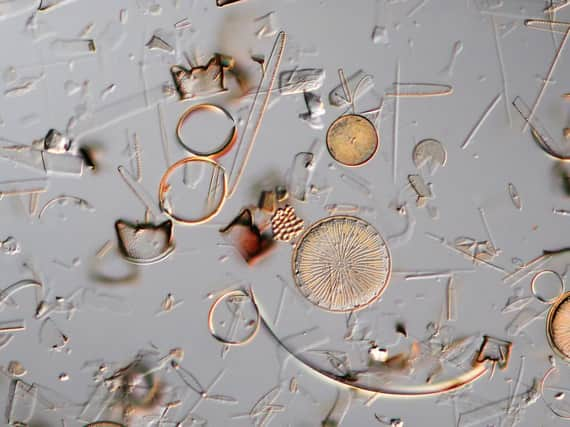Little word about the mighty diatom


Day-by-day, we experience a world full of plants and animals – trees, pandas and bamboo, cows and grass – and we trust scientists when they tell us that bacteria and viruses exist, even though they are invisible: their effects are only too obvious, especially as we enter the season of coughs and sneezes.
However, “there are more things in heaven and earth, Horatio, than are dreamt of in your philosophy”, as William Shakespeare’s Hamlet said. In between the large and the minute are the pretty small, which play a huge role in the functioning of our planet.
Advertisement
Hide AdAdvertisement
Hide AdNow, we need more experts working together more effectively to understand this hidden world better. The “inbetweeners” are mostly one-celled organisms, like bacteria but with a more sophisticated structure. Some behave like plants, others like animals or fungi, but they are none of these.
The oceans are changing
There are the dinoflagellates – speed-swimmers in armour that can make the sea luminous and produce some of the most powerful poisons known. There are the cryptophytes, too: busy turquoise, pink or brown balls with ejectosomes – little grenades that the cells throw out when stressed. The ciliates: ravenous, self-propelled hairbrushes. And finally, there are the chlorarachniophytes, which form creeping networks of linked cells, like mobile crochet. These and other strange small things touch our lives more than you might think. Try missing out every fifth breath – not easy, is it? About 20 per cent of the oxygen we need is generated by a group of plant-like organisms called diatoms, living in the world’s oceans. That’s more than all the world’s rainforests put together. It’s doubtful whether the diatoms will let us down, but we’ll need to keep an eye on them because the oceans are changing, becoming warmer and more acid because of the huge amount of extra carbon dioxide added to the biosphere during the last 200 years.
And some diatoms are very sensitive to acid. Remember acid rain? Fish deaths in Scandinavia? Perhaps you are younger than I am and this is ancient history? Well, there was a problem in the 80s: lakes and rivers in parts of Europe and North America were losing their fish and increased acidity was to blame. But no-one was sure what caused the acidity. Perhaps the lakes and rivers were becoming more acid naturally, or were changing because of long-term trends in land use, for example, from grazing to moor burning, or afforestation with alien conifers. Or, perhaps it was because of the sulphurous gases released by burning coal.
All or none could have been responsible and there were few historical records to help pinpoint the culprit. During research to establish the cause, diatoms played a vital forensic role. As well as being conveniently abundant just about everywhere watery, diatoms have evolved a special shell made of silica – the same stuff found in quartz, opal and glass – which resists decay after the cells inside die. As a result, under lakes and oceans there are vast deposits of diatom shells laid down in order, older ones buried by newer ones.
Fossil fuels
Not only that, each shell has a shape and pattern that tells us which species produced it. So, to find out whether and when lakes became more acid, researchers took samples from the layers of mud beneath and identified the diatoms present. They found that, even distant from cities and industry, the proportions of acid-loving species had increased since 1800 and the timing of the change showed that fossil fuels were to blame.
Prime minister Margaret Thatcher was convinced and her government took action to reduce acid emissions from power stations. Today diatoms are used to detect not only acidification, but also climate change, rises and falls in sea level, and pollution. The Scottish Environmental Protection Agency and Environment Agency uses them on your behalf to determine which of our rivers and lakes are clean and healthy and which need remedial action.
The key to successful diagnosis is correct identification of the shells and knowing what conditions each species needs to thrive. But, there are many diatom species – probably about 100,000 – and rather fewer diatom specialists who are scattered across the world and rather argumentative. Achieving consensus on a classification has evaded us thus far.
The internet is beginning to change things. In North America, diatomists have got together to create an online guide to identification (westerndiatoms.colorado.edu/), which will enable environmental protection agencies and scientists to do their detective work more effectively and consistently. However, Europe is lagging behind because no single country has the resources to do the job alone. Whatever our views on the politics of the EU, from a diatom perspective, more joined-up thinking is essential.
• David Mann is senior principal research scientist at the Royal Botanic Garden Edinburgh – see www.rbge.org.uk